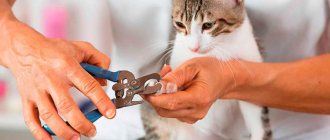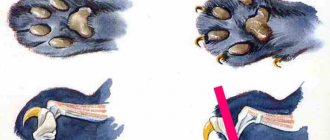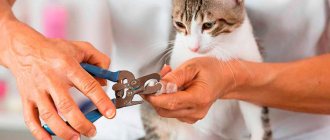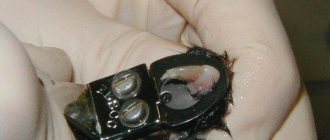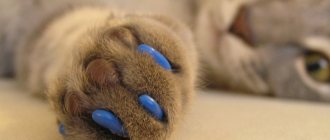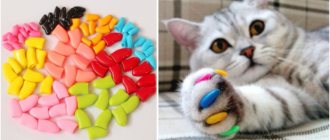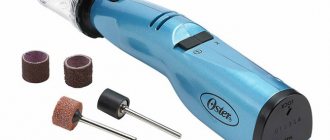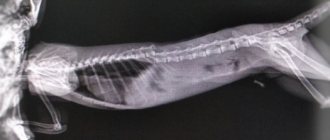Save the article:
Evolution has changed the appearance of cats, but has left such an important tool as claws unchanged. Cats can sort things out with rivals with the help of sharp claws, as well as get food and help take a high, impregnable fortress. This is all understandable if the cat is wild and a threat to the streets. But in domestic cats, declawing is a fairly common procedure.
Often, a pet’s claws are removed due to problems associated with the kitten growing up: no one likes damage to property, and even if the cat is particularly grumpy, the owners themselves may suffer.
The surgical procedure that makes a cat's paws “soft” is called onychectomy. During the operation, the entire claw phalanx is removed. In addition to cats, onychectomy is performed on dogs, primates and, if necessary, birds. Declawing is generally carried out according to indications and always under general anesthesia.
At what age can a cat be declawed?
Owners who are thinking about having a cat declawing operation are concerned about the question of when they can start the procedure. But before taking such extreme measures for cats who have the opportunity to walk, take into account that the animal will remain defenseless.
A kitten should not have its claws removed: their soft scratches do not cause harm; the body continues to form. In addition, it is absolutely cruel to subject a child to such stress.
According to the veterinarian’s recommendations, declawing surgery is performed on a kitten no earlier than 6-7 months. But it would be better to do it within a period of eight months to a year: the cardiovascular system has already become stronger, and the cat will have to get used to the consequences of walking without claws and adapt again in life situations. Therefore, if the owner has already decided to take such measures, then there is no need to delay and wait - in the absence of serious medical contraindications, the operation is easier to tolerate at a young age.
Veterinary clinic services Operation “Soft Paws” (Declawing) - reviews
Martasa
https://otzyvy.pro/reviews/otzyvy-udalenie-kogtey-59981.html
Advantages: The cause of many troubles is eliminated.
Disadvantages: The procedure is not for the faint of heart.
When you get an animal in your apartment, you don’t fully realize all the delights that await you. This happened to me too. We got a smart and beautiful cat, but nothing can be done about animal instincts. She didn’t cause us any particular problems, but torn furniture, torn wallpaper and scratched children were the height of arrogance. Being in the interesting position of expecting a child, I heard about the “soft paws” operation, this is the name of the declawing operation. Without hesitation, I went to the veterinary clinic
UEYU
https://kupi-slona.com/catalog/uslugi-vetklinik-operaciya-myagkie-lapki-udalenie-kogtey-3/557277
It’s hard to even give a rating after experiencing all this! Our cat has been living with us since birth, and in 4 years he has become my son! We love him very much! My daughter is crazy about him! I am writing this in order to understand that we do not use it as a toy or entertainment!
Makeda
https://www.u-mama.ru/forum/family/pets/380382/2.html
Here is almost the first link.
The operation to remove claws (onychectomy) is not very simple - in fact, the cat’s claw phalanges are removed. The operation is performed under general anesthesia. The animal suffers irreparable harm to its health. As a result, the cat becomes disabled. Onychectomy very often leads to complications, such as bleeding, swelling, and blood poisoning. And that is not all. When walking, cats focus only on their toes, and not on the entire foot. Shortening the foot after surgery by just one phalanx of the toes leads to a decrease in the area of support. As a result, the animal cannot walk normally. Uneven load distribution leads to disruption of the entire musculoskeletal system. The load on all joints increases. In the future, there is a high probability of problems with the spine and internal organs. The cat will have to learn to walk again. The sense of balance will be disrupted and this will affect her movements. There have been cases when, after surgery, cats died from painful shock. When an onychectomy is performed by an illiterate veterinarian, additional complications are possible - constant pain in the back and paws, infectious tissue damage, an abscess, and an incorrectly removed phalanx can begin to grow again, which will lead to severe pain. In such cases, a repeat operation and removal of another phalanx is necessary.
After declawing, a cat's character may change. An animal that cannot defend itself becomes angry, nervous and aggressive. It often happens that cats stop scratching and start biting. It turns out that the owner is exchanging one problem for another.
You will have to watch for a long time how, trying to jump somewhere, the cat will not be able to hold on with its paws and will fall to the floor, painfully hitting its muzzle. The spectacle is not for the faint of heart. The adaptation period is very long, and natural instincts will never disappear.
Luxury
https://www.woman.ru/home/animal/thread/4022925/
What did you like so much about yourself that you are now offering to everyone, snake? I did not ask the opinion of moralists, and in no way do I support this operation! And I ask those. those who have already done so, ignore the rest!
Diva
BURN YOU FOR THIS, yay, first, really, remove your nail platinum and you’ll understand how cats tolerate it
Olesya
https://www.babyblog.ru/community/post/petsandcats/1695470
The cat lives happily with us. Furniture? I wrote about a child, a child is more important to me than a cat’s claws, can you imagine!? You have to be completely brainless to put your child’s health at risk for the sake of such inadequate and pitiful reasoning! Why start? I pick up cats and dogs from doorways and on the street that people like you throw away. I sterilize, vaccinate, feed, and take care of them. So I don’t need to be brainwashed with my “good” thoughts.
Pattles
https://otzyv.expert/nuzhno-horosho-podumat-prezhde-chem-sdelat-eto-1477673
Advantages:
furniture intact
Flaws:
one big minus
Details:
and so, let's start with the fact that I am a veterinarian, and strangely enough, I am against this operation! Yes, it’s easier for the owners when the cat doesn’t peel off the wallpaper, doesn’t scratch the furniture, carpets, doesn’t tear you up, but imagine what the cat will survive! Claws are, first of all, protection, God forbid such a cat gets into the street, the percentage of the fact that it can escape from a dog drops to almost 0, since it cannot help but climb a tree or simply punch the dog in the face! But even those cats that never go outside will not be happy that their claws were cut since they are not protected from falling, and since cats love to walk on tops, there is a very high probability of falling from somewhere!, which does not always go unnoticed ! And the operation itself is difficult for the animal, it is difficult to tolerate, the paws are swollen, bleeding, painful! And the doctor does not always perform the operation correctly, which can subsequently lead to the appearance of claws again! Dear owners, I ask you to think carefully before doing this operation, because now there are so many nail clippers, it is enough to trim the claws once a week and there will be no problems, or protective caps on the claws, this will preserve both your furniture and the health of your pet! You can accustom an animal to a scratching post, but it’s not easy, but it’s still possible, I have a Maine Coon and you can’t imagine what kind of claws there are, but we only sharpen them on the scratching post or wear caps!! And no problems!!
Evgesh@. Thinker (8656)
https://touch.otvet.mail.ru/answer/219751115
do not torture the animal... Try cutting off the phalanges of your fingers... (this is the same thing, a very painful and painful procedure for a cat...)
NeZabava
https://www.flylady.ru/fly/viewtopic.php?t=16020
We have a cat. Big, beautiful white cat.
While we are living in the apartment, he tore up all the wallpaper and doors. Sometimes he scratches me, he can scratch his daughter if I don’t see him, and if his daughter offends him.
And now we have a question about moving to a new house. My husband is categorically in favor of “soft paws” - everything in the house is new - doors, plaster, wallpaper (but there is none yet), but I still can’t agree. My heart bleeds, I feel sorry for the cat.
I won’t let him outside - firstly, he is white and washing him after every walk will not bring pleasure to either him or me, secondly, there are fleas - and I am against fleas in a house where there are small children, thirdly, he neutered and very domestic (he has never left the apartment in his entire life), so I don’t think he will go outside.
So I don’t know what to do, my conscience is tormenting me. And time is running out... We're moving in about a month, but after the operation I want to keep him in the apartment, in a familiar environment, so that there is no double stress.
From what they did for the claws - trimming the claws - he managed to scratch the wallpaper with the trimmed ones, even tried to “smooth” his claws with a nail file, all to no avail. He either removes the caps immediately or bites off the tip so that the claws can be released through the cap. She doesn’t accept the scratching post, she’s been lying around in the closet for 3-4 years now, they’ve sprayed her with valerian and other cat remedies - all to no avail - she’ll fall over her, hug her and sleep with her, but she doesn’t sharpen her claws.
Does anyone have experience with “soft paws” surgery? I talked to veterinarians, everyone says that there is nothing wrong and that the cats continue to live in peace, but they make money from this, how honest will they be?
Molly Poe
A colleague has a British woman with her claws removed. The cat was my daughter’s, she had surgery and gave it to her mother “for rehabilitation.” The cat was under severe stress for 2 months, cried, did not run, and now looks more satisfied with life. She did not return to the previous owner) So she settled down “in rehabilitation”, for the second year now. Does not allow himself to be touched by his paws.
Pussicat
https://otzovik.com/review_6546513.html
Advantages:
No torn wallpaper and tattered furniture
Flaws:
No
They write some kind of passion here (everything is fine with us; we had our nails removed a year ago. The first day, and of course, a terrible recovery from anesthesia, but already on the 3rd day, as if nothing had happened, he was playing, running around and everything is fine) there are no violations or aggression) good good cat! walks normally, has not given up the tray. if I think of another cat 100% Soft Paws!
Shpantak-Ann
https://otzovik.com/review_7229539.html
Advantages:
The apartment has all the furniture, wallpaper
Flaws:
no cons
My husband and I bought a British kitten and at that moment lived in a rented apartment. I thought about this operation for a long time, I was afraid for the animal, because I read reviews on the Internet that the cat would remain disabled, the claws would still grow and grow into the pads, he would no longer be able to jump high and far, and would not be able to protect himself. The cat grew up and even though he had a claw sharpener, he still started tearing up the furniture, even in a rented apartment, and the question became whether to give the cat to his parents or have an operation. I really didn’t want to give him away, we got so used to him that we decided to have the claws removed from his front paws, they performed surgery on him, took him away in the morning, and took him away the next day in the afternoon, he was under the supervision of doctors, recovered from anesthesia from them and was returned to us already a normal cat, but he had to wash his paws in vodka or alcohol for 3 days, morning and evening, which he really didn’t like. Although they said that it would be painful for him to jump and walk for the first few days, we didn’t have that, he immediately jumped and ran as if nothing had happened) he was 6 months old when the operation was performed, now he is 2.5 years old, he jumps on top cabinets, the height to which it is physically possible for him to jump. The apartment is full of furniture and wallpaper, and our hands during games)) I don’t regret at all that we decided on “Soft Paws”.
Critic's opinion
https://irecommend.ru/content/myagkie-lapki-eto-khirurgicheskoe-vmeshatelstvo-znachit-nuzhno-kak-sleduet-podumat-tak-li-ne
For a long time I could not decide on this operation. I put everything off until later - I felt incredibly sorry for the cat...
But the question arose:
- Or the cat moves with us to another city to a rented apartment, where no one will tolerate damage to furniture and wallpaper, like at home (we are already replacing the second sofa in 4 years),
- Or you will have to give it to your parents, friends,
- Or... that's where the thought stopped...
Looking through a bunch of reviews about the “soft paws” operation, I was convinced that mostly those who don’t have cats say negative things! I can understand them, what advantages can you find if you only see the suffering of an animal?
*********I would love to see the look on your face when the cat starts tearing up your fresh textile wallpaper! And what you will do to her in reality after this.************
***But, back to the topic... The day of the operation***
The day before the operation, the veterinarian told me to feed the cat in the evening and remove the bowl, and not give anything to eat in the morning.
As a result, in the morning, while I was getting ready for work, a “tail” followed all family members everywhere, begging for food and faithfully looking into their eyes. This was a turning point. I feel sorry for my favorite one. And because she’s hungry, and because you understand what’s in store for her, but she doesn’t...
Next I am writing from the words of my husband...
It was difficult to get it into the carrier. The cat realized that “something was wrong” and became quick, so I had to tinker!
A friend works at the veterinary clinic and told her to leave Our Dasha and come in about 2 hours. But the operation ended earlier and my husband received a call about an hour and a half later. By the time my husband arrived at the veterinary clinic, Dasha had already begun to recover from the anesthesia.
_____________***At home we were able to observe all the wonders of balancing act!*** ______________
The cat didn’t want to sit still, she walked staggering around all the rooms, constantly falling and looking for corners (which looked very strange):
- Dasha found some corner;
- She poked her muzzle into him and fingered him with her paws;
- Apparently, it seemed to her that it was walking somewhere...
Also, she was terribly cold, probably because of anesthesia her body temperature drops (at least it was the same during sterilization).
The postoperative period is coming to an end
The operation was performed from approximately 11 to 12.30. The family was able to watch Dasha for up to three hours, they controlled her. They removed the chairs she crashed into and blocked the path to the radiator where Dasha wanted to warm up.
But when they left, the cat was able to get to the battery and burned her entire face!
I saw her in the evening, Dasha looked like Joan Watson from the series “Elementary” - slanted almond-shaped eyes and ruddy (from a burn) cheekbones.
They smeared panthenol on the burns and examined the paws. She let them look at them without any problems, maybe the painkiller they injected her was still working? They didn’t wrap our paws, they just treated us with some kind of antiseptic silvery thing. Hard threads stick out in place of the claws.
- In general, the cat looked lethargic, sleepy, and tired.
- She ate poorly, but she was still able to eat sausage from her hands. I drank water, but not much.
- By evening she was already jumping onto our sofa, and once she jumped off herself. I don’t know who was more scared by this jump: the cat or me.
But I tied a scarf around me and carried Dasha in it (probably the feeling of guilt got the better of me). And she didn’t resist. You lay there contentedly - warm, good, they stroke you and carry you everywhere with them.
In the evening, the cat fell asleep on the sofa, like a king - in a pile of rugs and blankets. They didn’t drag her, they put her next to the sofa, on the floor, with sofa cushions for Dasha to climb down on them. But she never got up during the night.
On the second day they didn’t bother with her like that anymore. And the cat confidently stepped on its paws. True, they still didn’t let her jump from above; they tried to take her down to the floor themselves.
That day Dasha began to pull the threads out of her paws. And since the cat has bad teeth (as we were told, her gums are inflamed), we treated her oral cavity with a solution of furatsilin, otherwise she would get an infection and her paws would become inflamed...
***Generally***
- The operation is scary... for cat owners. It’s hard to cope with feelings of guilt and pity for your pet...
- I did not observe the suffering of the animal itself - the cat did not scream in pain and quickly recovered.
- But still, “soft paws” are a surgical intervention. This means that you need to think carefully about whether surgery is really necessary?
Here is our result on day 10 after surgery:
Thanks for any comments! I perceive serious attacks only from owners of “scratching” cats, and not from outside observers...
Alexa_R
https://irecommend.ru/content/ne-tak-strashen-chert-kak-ego-malyuyut-83
I’m looking forward to throwing slippers, but... I read somewhere an opinion that this operation, or rather the owners who decided to do it, are cursed by those who don’t have cats. Perhaps this is true. Let me make a reservation right away that in no case do I recommend and, moreover, do not encourage anyone to undergo this operation; everyone decides for themselves, since the matter is really not a joke.
As usual, I'll start with some background. We have a new family member, a little kitten. And the larger this miracle grew, the more aggressive it became. Unfortunately, his character turned out to be such a difficult one. I was ready for peeling wallpaper, jambs and an unhealthy love for furniture, since I lived with cats all my childhood, but I was not prepared for the fact that the cat would throw itself at everyone with the obvious goal of maiming. He attacked my husband and me when we were sleeping, mostly grabbing our faces. I often walked around with scratches either on my forehead or on my cheek. The child was afraid to leave the room in the evenings, as the cat regularly attacked him with its claws. My husband’s friend, who came to visit us, had his vein torn so that the food stopped bleeding. In general, our mustachioed friend behaved extremely undignified. The question became more pressing when I became pregnant with my second child. Realizing that if a cat attacks a newborn in the same way, trouble will not be far away. We contacted the veterinarian, he prescribed Api-San Stop Stress calming drops for the cat. You can read a more detailed review about it
Here . I can only add that the drops did not solve our problem. And so, when there was no time to wait for changes in his behavior, we decided to remove the claws.
They took the cat to the clinic at 10 a.m. and picked him up at 5 p.m. After anesthesia, he counted all the angles; he did not want to lie still. Therefore, I had to sit with him and not let him wander around the apartment again. The paws were tightly wrapped, which caused discomfort in the cat and he stubbornly tried to remove the bandages. By morning, the anesthesia wore off completely, I had more strength and the bandages were removed. The first day we fought with the cat about this. We bandage it, he takes it off and starts gnawing on the stitches. The problem was solved in the following way: I cut off the children's tights, put them on the paws, and tied them in front and at the top. The cat was happy with this and calmly ran around the apartment in them.
4 days after the operation they gave painkillers, the cat behaved calmly, so I do not share the opinion that the animal is in pain. Two weeks later the stitches were removed. The cat feels great. He also climbs cabinets, doesn’t fall from anywhere, and strokes his scratching post out of habit. But some changes did occur, oddly enough, he became more affectionate, purrs, rubs. Now my son and I are chasing balls around the apartment, and after putting my two-month-old daughter to bed, I’m not afraid to leave the room and leave her alone with the cat.
This was our example of performing declawing surgery on a cat, and again, I do not encourage anyone to do the same. Everyone must weigh the pros and cons for themselves. The only thing I want to emphasize for those who may not be aware. This procedure is only suitable for domestic cats! If your pet periodically walks outside, just randomly runs out while you are closing the door, or you plan to take the cat with you to the dacha in the summer, you should under no circumstances remove its claws. This is their protection in the outside world. And yet, if you finally decide, do not forget to study the reviews about this operation in the clinic of your choice. Still, the qualifications of the personnel also play an important role.
And finally, a photo of my peacefully sleeping cat. It shows the front paw in all its glory. The brilliant green has not completely washed off for a couple of months, but the paw itself looks absolutely no different from the “clawed” one.
Advantages and disadvantages of declawing cats
global $ads_google;
//data-ad-slot=”2475549904″ $ads_google = empty($ads_google) ? false : true; ?> if ($ads_google == false) {?> $ads_google = true; ?> } ?> It doesn't take long to remove a cat's claws. But are there any advantages from this? Yes, I have. This is the impossibility of damaging furniture and the absence of scratches on the skin of household members.
But the disadvantages include a number of points:
- anesthesia is not just a dream, but stress for the body;
- the animal is in great pain for a very long time after the operation. The pain is dulled with various painkillers, which is also considered an intervention in the body;
- the phalanx may grow back and require repeated surgery;
- This is real stress for a cat, which not every animal experiences without consequences.
- a cat without claws is defenseless, and any trip outside can end in disaster;
- as a result of onychectomy and a feeling of vulnerability, the pet may use its teeth;
- the pet’s character changes, it may become withdrawn;
- Difficulties with the toilet: sometimes cats refuse to go to the litter box due to the inability to rake;
- the animal will never step on the entire foot completely again in its life, which affects its gait.
Therefore, maybe it’s worth thinking about other options for protecting furniture from cat scratches?
Alternative to surgery
There is a way to solve the problem peacefully. These are practical silicone pads that are attached to the phalanges using hypoallergenic glue. Anti-scratch guards are available in different colors and sizes, so that the claws of both a kitten and an adult animal can be neutralized.
The only drawback is the need to change the anti-scratch pads every month for hygiene purposes. We recommend that you contact your veterinarian to perform this procedure. The doctor of the Kaliningrad Regional Center of Veterinary Medicine will select the optimal size pads and glue them to the phalanges with minimal stress for the pet. Result: the sharpness of claws will become a thing of the past along with damage to wallpaper and furniture. In this case, the goal will be achieved without injuring the cat through surgery.
To avoid waiting in line at the veterinarian, we recommend making an appointment in advance at the branch that is closest to you. Contact numbers are listed in the “Contacts” section.
Description of declawing surgery
Onychectomy is banned in a number of European countries.
Local anesthesia is sometimes used for the operation, but general anesthesia is more often used.
The claws are removed entirely from the first phalanx of the finger. A suture and anesthetic ointment are applied to the damaged area. Then the paw is bandaged, and a collar is put on the cat’s neck, which will protect the seams from licking.
Along with the application of anesthetic ointment, auxiliary injections are administered.
Possible complications
The first risks are associated with anesthesia. 2% of animals die, even if the patient is healthy and no mistakes were made. There is a high likelihood of an acute immune response, heart and lung problems. Possible disruption of the brain, liver and kidneys, hypothermia - entire textbooks have been written about the consequences of anesthesia.
Modern drugs and hardware monitoring during surgery significantly reduce risks. Therefore, you need to be careful when choosing a clinic, without skimping on transportation, the presence of an anesthesiologist, or hospital care.
| Complication | The essence | Frequency |
| Pain syndrome | Even soft tissues hurt after surgery, and fingers are bones, cartilage, joints, many vessels and nerves. Severe pain must be treated with opiates. | Always |
| Bleeding | There are many relatively large vessels in the fingers. The first day after the “Soft Paws” operation, cat care requires medical supervision. Often the suture is opened due to bleeding. The problematic vessel is cauterized. | Often |
| Phalanx regeneration | Instead of scarring, the amputated finger begins to grow. The claw is formed incorrectly, bent at any angle, including inside the soft tissues. Repeated surgery will help. | Often |
| Abscess | Before the procedure, the hair on the paw is not shaved. This and violation of aseptic standards leads to inflammation of the sutures, purulent lesions, and necrosis. | Rarely |
| Osteomyelitis | Purulent-necrotic inflammation of bones and bone marrow. The amputation site acts as an entry point for infection. | Often |
Long-term use of antibiotics is necessary to suppress dangerous flora. The soft tissues heal quickly - after a week the suture fuses. But when removing the phalanges, they cut directly along the bone, and it takes longer to regenerate. A competent veterinarian will insist on SSD antibiotics for at least a month to avoid local infection.
Consequences of deletion
After the operation, the following consequences may appear:
- soft tissues after such an injury on the paws become inflamed, which is fraught with the onset of a necrotic process;
- Losing a large amount of blood during the declawing procedure complicates the healing process;
- impaired coordination of movements;
- difficulties associated with recovery from anesthesia.
Before the operation, consult a doctor at the clinic and identify the presence of serious medical indications: sometimes the cat actually needs to have 1-2 claws removed. In any case, first assess all the risks, and then begin the procedure.
When is the operation performed?
First of all, it is worth noting that the removal procedure should only be performed on young animals. In this case, the rehabilitation period will be up to 7 days and the rate of wound healing at an early age is quite high. A prerequisite is that the pet must be kept at home at all times. After all, after the operation, the cat remains defenseless in the event of an attack by yard animals; it will not be able, for example, to hide from danger by climbing a tree.
The owner must understand that he will have to keep the cat only indoors for its entire life, and in cases where it is necessary to transfer the animal to another owner, warn him about this feature of the pet.
There are still good reasons why the procedure is mandatory:
- the animal's health condition, which requires immediate intervention;
- some diseases in the owner or his family members. For example, diseases of the immune system or blood, in which scratches can have serious consequences for a person's health. Onychectomy may also be performed if the owner is an elderly person taking blood thinning medications;
- in cases where the animal causes significant damage to property and has no contraindications. The owner must weigh the risks to the cat's health and take into account the possible consequences.
[AdSense-C]
Despite all the reasons against it and protests from animal welfare communities, declawing is becoming a popular and even fashionable procedure. However, the price for peace of mind, if the cause is only damage to furniture, is sometimes quite high.
Cost of the procedure
Prices for onychectomy (sometimes indicated on the price list as “Soft paws”) are usually quite high and not every veterinary clinic provides this service. Regular nail trimming can be much cheaper. In the regions of the Russian Federation, the cost of the operation is up to 2000 rubles, in Moscow – up to 4000-5000.
Rehabilitation of cats after onychectomy
When the cat's claws are removed, the process of recovery after surgery begins, both for the condition of the paws and for the entire body. Fluffy needs the caring attitude of the owner.
There are a number of nuances for caring for a cat:
- pain relief in the form of injections, if necessary;
- daily treatment of wounds;
- the dressing needs to be changed regularly;
- A visit to the doctor is recommended once a week
.
The cat is really looking forward to its owner's love and care, only in this case it will get better sooner.
The recovery period after surgery lasts a month. During the first few days it is painful for the cat to stand on its paws; it will be hampered by pain and discomfort. Then the walking process gradually improves, but the cat may limp.
It is better to remove the cat's claws first on the front paws and then on the back paws. One by one deletion is allowed. This requires expert advice.
Alternatives to surgery
Onychectomy is a radical method. You can solve the problem of furniture damage in other ways that have a temporary effect:
- nail trimming (can be done independently or in veterinary clinics);
- the use of anti-scratch pads - silicone overlays on the claws, which are attached using special glue (they need to be changed monthly);
Silicone claw covers need to be changed once a month.
- training to use a scratching post;
A cat can be trained to sharpen its claws in only one place
- the use of repellent sprays (they contain natural ingredients that are safe for animals);
- purchasing toys that will distract your cat from scratching furniture.
Video: how to avoid damage to furniture by cats
Cost of declawing
global $ads_google;
//data-ad-slot=”2475549904″ $ads_google = empty($ads_google) ? false : true; ?> if ($ads_google == false) {?> $ads_google = true; ?> } ?> If we take into account the price of declawing a cat within the central district of Russia, then the total cost can range from 1,500 to 5,000 rubles. The status of the clinic, the skill of the doctor, and the distance from the city center play a role.
There are veterinarians who specialize in surgery, and they should be given preference.
If you call a doctor to remove a cat’s claws at home, the price will not increase much, and healing will be faster.
Why do cats sharpen their claws?
First of all, let’s clarify the very concept of “sharpening its claws.” The fact is that cats sharpen their claws with their teeth, and when they scratch any surface, they try to get rid of the old claw shell, and sometimes even the old claw, to make room for a growing one.
There is a second reason why cats love to sharpen their claws. This triggers the instinct to mark territory. On the cat's front paws there are glands, the secretion of which is applied to the surface when scratching. This is how she marks her territory, where she feels comfortable and calm. In addition, scratching is also a muscle workout, especially in the morning and after sleep.
Safe Alternatives
The problem with torn wallpaper and furniture is easy to solve - the cat needs a play complex with tunnels, several levels, hammocks, and posts. It's expensive, but if you want, you can assemble it yourself - nothing complicated. Cats will love mint scratching posts if they reward their use with a tasty piece.
Silicone pads will help out as a temporary solution for the period of re-education. They also change their gait. Under the hood a favorable environment is created for the development of fungi and bacteria. The cat might swallow the pad, but it depends. But this is not as dangerous as the consequences of onychectomy.
They fight aggression in a comprehensive manner - they turn to veterinarians, ask for advice from experienced breeders. If you find the reason for the lack of trust in your hands, you won’t have to remove the cat’s claws. When there is no time or desire to solve the problem in another way, it may be worth considering the option of transferring the cat into good hands.
It is important to recognize that a domestic cat's behavioral problems are the fault of humans. Even if there was a good reason, it was the person who didn’t look, missed, or didn’t find the time to correct behavior right away when it was easy. It's not fair that animals are responsible for our mistakes.
Recommended age for surgery
It is not true when they say that small kittens tolerate the procedure more easily. This is stressful for the baby, and the body is still developing, and the claws are still small and safe. Veterinarians recommend spaying or neutering first, after which the animal often becomes calm.
But if an onychectomy is to be performed, then the appropriate age is 8-12 months. Before removal, the animal is prescribed tests and examination to identify heart and vascular diseases in order to determine what to use: anesthesia or anesthesia. Then the doctor specifies the date of the operation, the number of claws to be removed, or recommends that the owners refuse.
Operation price
If you decide to have an onychectomy, you should not save money. You should entrust the operation to a highly qualified specialist and a veterinary clinic, where your pet will be provided with proper attention.
Entrust the procedure to a highly qualified veterinarian, find out about the experience of performing similar operations
The price for the service is 50-70 dollars. Laser declawing is performed in few clinics and costs approximately $150.
Veterinarians' opinion
Reviews of the “soft paws” procedure for cats are left by veterinarians all over the world. Many clinics decide to perform such an operation. However, there are many veterinarians who will not perform such a procedure at any cost without a special prescription.
Experienced experts around the world do not recommend declawing a cat. They believe that there are many alternative solutions that can be tailored to each animal. Even if the procedure is performed correctly and does not produce any physical complications, the cat’s mental and emotional state will deteriorate significantly.
Owners will need to spend a lot of time to ensure that their pet feels protected. Sometimes, according to veterinarians, it becomes simply impossible to regain a cat’s trust in its owners.
Rehabilitation period
The recovery period depends on the quality of the work performed, the professionalism of the veterinarian and the cat’s reaction to the operation.
A high-quality procedure is the key to a quick recovery
Immediately after the procedure, the cat will sleep: do not be alarmed, the animal may pee under itself and this is a normal reaction to anesthesia.
For the first few days, your pet will not be able to walk: he will be bothered by pain in his paws, joints and back. Use an Elizabethan collar and do not allow your pet to touch the bandages. Every day it is necessary to treat the seams and make sure that the cat does not lick them. Walking outside is completely excluded during this period: there is a high probability of infection of the affected tissues.
IMPORTANT: place the tray, bowl and bed as close to each other as possible, thereby reducing the distances your pet will have to travel!
The meaning of claws in a cat’s life: “basic instinct”
Domestic cats and cats living their lives in apartment conditions are not quite the same as their wild ancestors. It is enough to turn to a simple example and draw an analogy with a private house: in the latter case, many owners allow the animal to spend time outside, and this significantly changes the essence of the issue.
What is the difference? Scratching is not just part of basic nail care. In nature, a domestic animal realizes its instincts: it hunts, snatches prey, climbs trees and, most importantly, marks its territory with the help of its claws, leaving the secretion of glands on the paw pads on the surface, thereby showing “who’s boss.”
All this allows the animal to maintain psychological balance and feel comfortable in the territory.
One of the strongest cat instincts is to mark its territory.
Cost of the “soft paws” procedure
The price is affected by the level of services and location of the medical institution. Moscow clinics ask for 2-5 thousand rubles. for such an operation. In remote centers the cost is reduced to 1 thousand. Due to the complexity of the operation, it is worth choosing a specialized clinic, or better yet, where the doctor comes to the cat’s home. Such a call will cost more, but the pet will recover faster.
Another reason for contacting a specialized institution is the reliability and honesty of the staff. Now that few people undertake onychectomy, there are many advertisements with false promises.
For unfortunate surgeons, the main thing is money, not caring for the animal. Often operations based on such advertisements are carried out without following the correct technology and in violation of sterility. Such assistance, when inflammation begins, sometimes ends in amputation of the paw.
A cat's claws are vital
Carrying out the operation
When considering prices and reviews of the “soft paws” procedure for cats, you need to start by learning how to perform this operation. Claws will be removed only on the animal’s front paws (after all, only with them does the cat damage the furniture). It is best to do this when the animal is between six months and a year old.
The animal is placed under general anesthesia. The procedure takes about half an hour. The postoperative period is about 3 days. At this time, bandages remain on the animal’s paws. Be sure to put a special collar on your cat. The four-legged pet must lie in a cage during this time. This will reduce his mobility. Do not put litter into the cat's litter box during the postoperative period. You can use plain paper.
Over the next few weeks, owners should give their cat maximum attention. He will get used to his new state. At this time there is a risk of injury. If the operation is performed by an untrained person, without the proper level of qualifications, the animal may remain disabled for life.
Consequences of surgery for cats
Benefits of declawing. This procedure only benefits the animal if recommended by a veterinarian. Even in these cases, only the affected phalanges are removed. And for the sake of their own peace of mind, animal owners subject their pets to mental trauma and physical damage.
List of disadvantages:
- On the first day after anesthesia, the animal, like a person, does not feel well, refuses to eat, and is unable to walk.
- It’s been painful for the cat to walk for at least a month, so she has to learn again. This is already a disabled person without a soft and graceful gait.
- The pain will have to be relieved with painkillers, which is harmful to the body.
- Sometimes the phalanges grow back, which will require repeated intervention.
- An animal without claws is unable to defend itself, so it begins to bite.
- A feeling of defenselessness often leads to isolation, unsociability or fearfulness.
- Cats without claws refuse to “do business” in the litter box because they have nothing to scoop out the litter with.
- Dexterity and coordination are lost, and it is difficult for the animal to maintain proper balance.
- Soreness will make the pet inactive, and this will affect the internal organs - the condition will worsen.
- Possible bleeding, infection in wounds or osteomyelitis.
Consequences, risks and complications
The psychological consequences can be unpredictable: adapting to a new lifestyle and experiencing severe stress, the animal can become irritable, withdrawn, and aggressive. Having lost a vital organ, a pet may perceive this as a danger and begin to avoid people. The situation is fraught with problems with going to the litter box: the cat may lose interest in the box due to the inability to “bury” the filler.
Possible physical effects, risks and complications include:
– prolonged and severe pain, inability and discomfort;
– deterioration of condition after anesthesia;
– violation of coordination and functions of the vestibular apparatus: the center of gravity shifts to the entire paw;
– osteomyelitis: inflammatory infectious disease of the bones;
– curvature of the spine, joint diseases;
– risk of developing an inflammatory infectious process;
Legality
Cosmetic veterinary surgery is popular in the United States - animals have ligaments cut, piercings, and implants inserted. But even in their historical homeland, the “Soft Paws” procedure is abandoned due to the negative impact on health and quality of life. Declawing without indication has already been banned in 12 states.
In European countries, onychectomy without medical indications has long been prohibited; it is considered intentional mutilation. This is not a subjective attitude, but a legal definition of the essence of the process. A complete ban applies in the following countries:
- Great Britain
- Netherlands
- Germany
- Denmark
- Sweden
- Finland
- Norway
- Australia
- Israel
- Brazil
- Portugal
- Czech
- Serbia
- Belgium
- France
- Italy
- Spain
- Ireland
In Russia, a project to ban euthanasia, cupping and onychectomy without indications is under development. It will complement the already adopted Responsible Animal Welfare Act. Many breeders stipulate a ban on the removal of phalanges in the sales contract, but it is difficult to track its implementation. About a third of Russian clinics do not provide this service.
